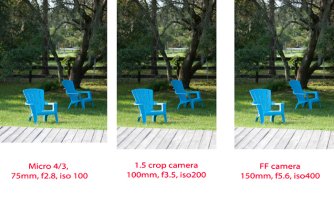Relationship of DOF to format size
The comparative DOFs of two different format sizes depend on the conditions of the comparison. The DOF for the smaller format can be either more than or less than that for the larger format. In the discussion that follows, it is assumed that the final images from both formats are the same size, are viewed from the same distance, and are judged with the same circle of confusion criterion. (Derivations of the effects of format size are given under Derivation of the DOF formulas.)
“Same picture” for both formats
When the “same picture” is taken in two different format sizes from the same distance at the same f-number with lenses that give the same angle of view, and the final images (e.g., in prints, or on a projection screen or electronic display) are the same size, DOF is, to a first approximation, inversely proportional to format size (Stroebel 1976, 139). Though commonly used when comparing formats, the approximation is valid only when the subject distance is large in comparison with the focal length of the larger format and small in comparison with the hyperfocal distance of the smaller format.
Moreover, the larger the format size, the longer a lens will need to be to capture the same framing as a smaller format. In motion pictures, for example, a frame with a 12 degree horizontal field of view will require a 50 mm lens on 16 mm film, a 100 mm lens on 35 mm film, and a 250 mm lens on 65 mm film. Conversely, using the same focal length lens with each of these formats will yield a progressively wider image as the film format gets larger: a 50 mm lens has a horizontal field of view of 12 degrees on 16 mm film, 23.6 degrees on 35 mm film, and 55.6 degrees on 65 mm film. Therefore, because the larger formats require longer lenses than the smaller ones, they will accordingly have a smaller depth of field. Compensations in exposure, framing, or subject distance need to be made in order to make one format look like it was filmed in another format.
Same focal length for both formats
Many small-format digital SLR camera systems allow using many of the same lenses on both full-frame and “cropped format” cameras. If, for the same focal length setting, the subject distance is adjusted to provide the same field of view at the subject, at the same f-number and final-image size, the smaller format has greater DOF, as with the “same picture” comparison above. If pictures are taken from the same distance using the same f-number, same focal length, and the final images are the same size, the smaller format has less DOF. If pictures taken from the same subject distance using the same focal length, are given the same enlargement, both final images will have the same DOF. The pictures from the two formats will differ because of the different angles of view. If the larger format is cropped to the captured area of the smaller format, the final images will have the same angle of view, have been given the same enlargement, and have the same DOF.
Same DOF for both formats
In many cases, the DOF is fixed by the requirements of the desired image. For a given DOF and field of view, the required f-number is proportional to the format size. For example, if a 35 mm camera required f/11, a 4×5 camera would require f/45 to give the same DOF. For the same ISO speed, the exposure time on the 4×5 would be sixteen times as long; if the 35 camera required 1/250 second, the 4×5 camera would require 1/15 second. The longer exposure time with the larger camera might result in motion blur, especially with windy conditions, a moving subject, or an unsteady camera.
Adjusting the f-number to the camera format is equivalent to maintaining the same absolute aperture diameter; when set to the same absolute aperture diameters, both formats have the same DOF.

